News (in brief)
2025
FebruaryNorthern
Ireland Science Festival - Keith will be presenting "What is
life" to a public audience. A PDF copy of the presentation slides can
be found here
(it might take a few seconds to load) and comprehensive notes
accompanying the slides can be found here.
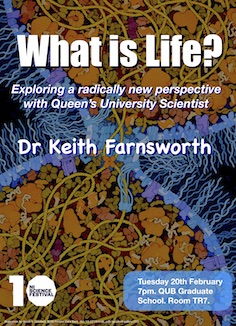

2024
JulyFrom now on please access this website using https://www.whatlifeis.info
That is because this website has now gained its SSL certificate, meaning it communicates securely with your browser and improves accessibility to modern browsers, some of which demand SSL. This came at quite some cost, but seems worth it in the long run. More interestingly, new content is underway and a lot of pages are about to be updated and improved. I have been very short of time for this over the past year, but things are about to change on that, so please do look forward to substantial developments here over the next few months.
I have been using the blog to address the topical and important issue of AI from the perspective of biological information theory. I had hoped for this to be a discussion via the comments facility, but unfortunately that turned out to be such a spam magnet, that it was not viable (I had to switch comments off after seeing hundreds of spams per day). Such is the internet now. We have also seen quite a lot of attempts to misuse the website; I think all have been thwarted, but there is a constant pressure from criminals trying to take over in order to push their illegal activities.
More interesting - new science.
It seems that not many colleagues have even noticed the development of a new understanding of how physical information constrains physical forces to produce all causes in the universe. Very few seem to have taken up the idea that with this knowledge, it is possible to explain downward and cyclic causation. For these reasons, I am writing another paper (aimed for Royal Scoiety Interface) which restates the new principles and applies them in the topical field of information decomposition (a hot topic in computational neurosciences at the moment) as well as explaining homeostasis and the emergence of community ecology. Let's see if that has the desired effect.
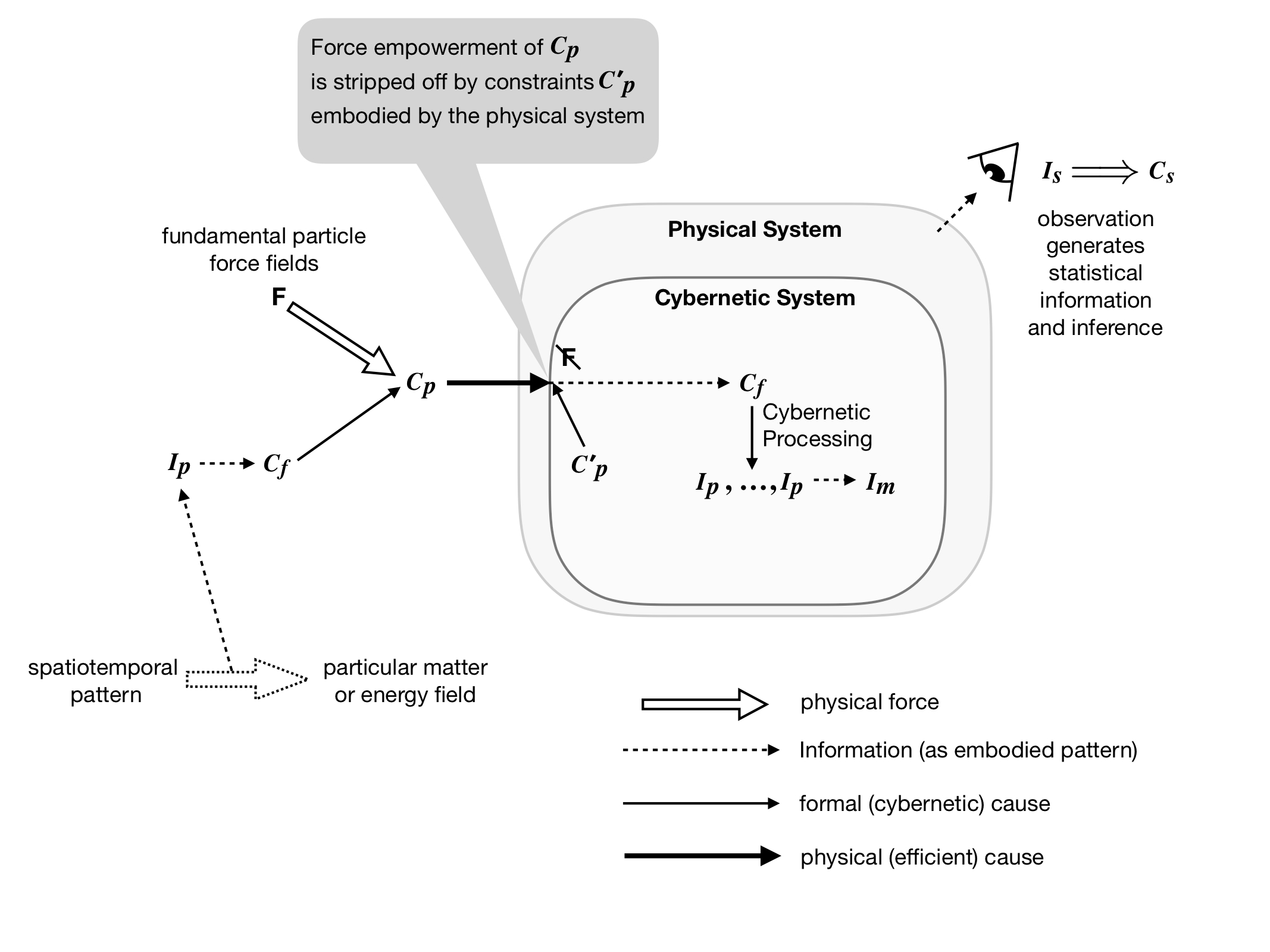 Distinguishing
three
kinds of cause: physical cause C_p is the constraint of physical force
F by physical information I_p, whcih in turn is the arrangement of
matter or potential of an energy field in spacetime. Cybernetic
systems consist solely of formal information I_f, which is effectively
an abstraction of I_p. In cybernetic systems (such as algorithms and
the information processing of a brain), different I_f are processed,
giving the appearance of cybernetic causes C_f (f since they are
entirely determined by formal information). When the cybernetic
systems are physically enabled to control physical systems (e.g. with
actuators such as motors), they have physical agency: the actuators
are systems where physical forces are constrained by the I_f. When we
observe all this happening, we might infer statistical relations among
items of I_f (e.g. signals or states of neurons). These inferences are
statistical information I_s and their apparently causal relations are
inferred statistical relations C_s. From these we derive information
metrics such as mutual information that can be decomposed, e.g. into
parts that include synergistic information.
Distinguishing
three
kinds of cause: physical cause C_p is the constraint of physical force
F by physical information I_p, whcih in turn is the arrangement of
matter or potential of an energy field in spacetime. Cybernetic
systems consist solely of formal information I_f, which is effectively
an abstraction of I_p. In cybernetic systems (such as algorithms and
the information processing of a brain), different I_f are processed,
giving the appearance of cybernetic causes C_f (f since they are
entirely determined by formal information). When the cybernetic
systems are physically enabled to control physical systems (e.g. with
actuators such as motors), they have physical agency: the actuators
are systems where physical forces are constrained by the I_f. When we
observe all this happening, we might infer statistical relations among
items of I_f (e.g. signals or states of neurons). These inferences are
statistical information I_s and their apparently causal relations are
inferred statistical relations C_s. From these we derive information
metrics such as mutual information that can be decomposed, e.g. into
parts that include synergistic information. 2023
SeptemberWell, the code biology paper has been published, after the reviewers (who liked it a lot) suggested I added some more examples. Doing that gave me the chance to firm up the explanation for the necesity of codes for semiotic influence. That is the communication from a source to a receiver which is not control, but rather can be interpreted as a signal to which a response may be made by the receiver. I think the explanation builds a bridge
between Barbieri's code biology and the Piercean semiotics (the rift between is described elsewhere). I will update the code biology page on this website to reflect the new insights. An update on autonomy is also in order.
The paper is published here by BioSystems.
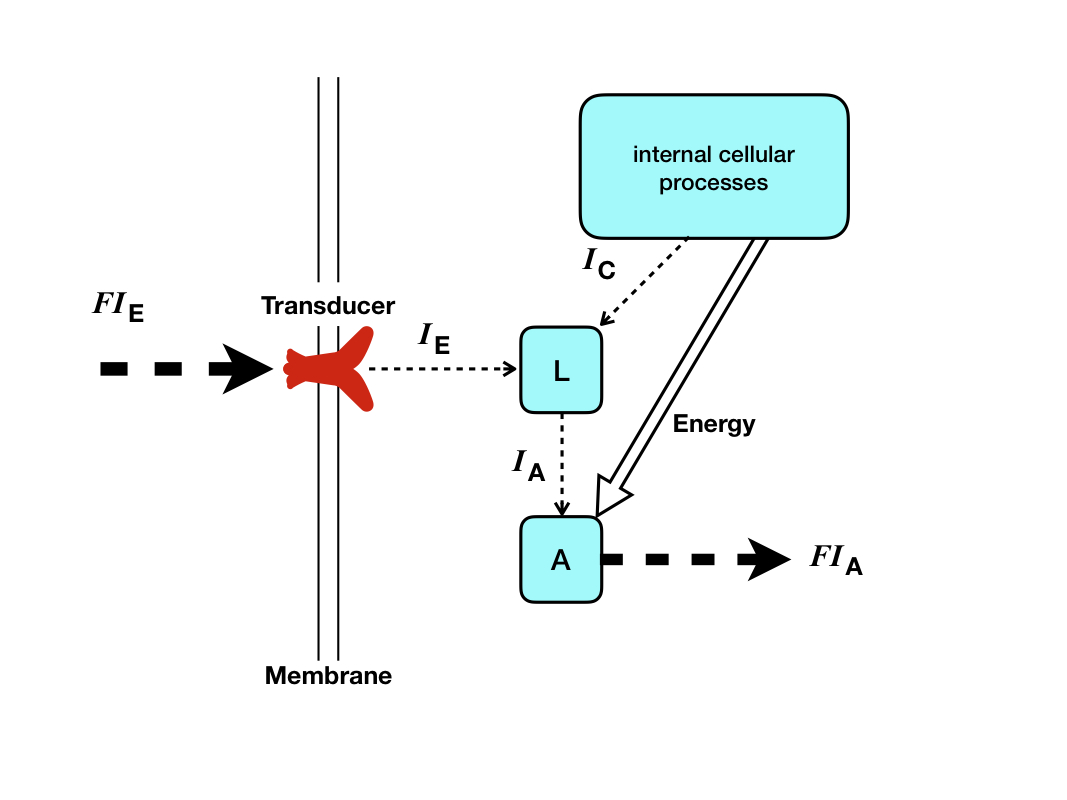
June
At long last, some might say, I am producing a work on code biology (for a special issue of BioSystems, Edited by code biology chief: Marcello Barbieri , due to appear later this year. My topic is "how codes enable the autonomy of organisms". I use my theory of causation (see 2022 entry below) to show that organisms need at least a way to remove the compulsion of physical forces from exogenous causation and also a way to preserve formal information to be used as a source for internal causation. The former is achieved through coding transducers; the latter through molecular codes. The deadline for submitting it is the end of this month, so it is nearly done.
I am also in the early stages of writing a classical theory of value based on information, hopefully with a well respected theoretical economist. That will probably progress in the Autumn.
April
So far it has been rather hectic, so I am sorry I have not been updating and building the website for a while. However, I did find a new application for the ideas being developed here. It is in the explanation for pain - felt by all but a few (imparied in this faculty) humans; all mammals and birds (we are sure), probably all vertebrates and many invertebrates too (octopus and some crustacea by UK law), but probably most arthropods and at least some moluscs, including, of course the cephalopods. Feeling pain is far more than nociseption - the signal that informs the body of potential, or actual, damage. Feeling is definatively only for sentient creatures, so the question of which species can feel pain has largely revolved around sentience. Working with Bob Elwood, I took a different line, asking what organism information processes require pain in order to work. I identified those which make action-selection decisions based on internal appraisal of the anticipated outcomes of possible actions. There is mounting evidence that many insects and a host of other animals can do that. The distinction between needing pain and not, is the same as the distinction between anticipatory appraisal vs. just running a behavioural algorithm. The work is published in Animal Cognition, available here, with a free preprint on ResearchGate. I introduced the topic in a Blog entry (see whatlifeis.info/Blog/index) and I give a link to an accompanying lecture there.
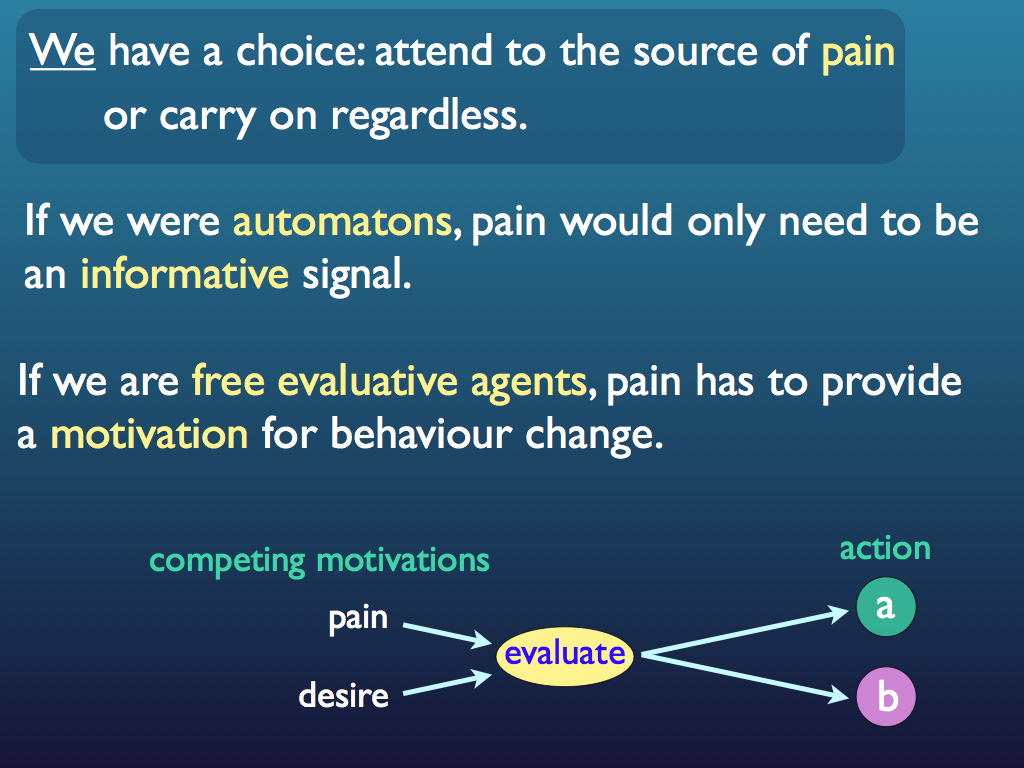
2022
Work on causation, especially its physical basis - the interaction between fundamental physical forces and formal information constraint (see the Physical Basis of Causation) has led to a new integrative and unifying theory of cause, published as "How an information perspective helps overcome the challenge of biology to physics" (the link goes to the open access version at Science Direct, if that does not work, you can try the doi https://doi.org/10.1016/j.biosystems.2022.104683). I describe the ideas in more accessible language on the blog as well.A little interaction with Marcello Barbieri has motivated me to get the code biology page into shape: more on that expected shortly.
2021
Oh dear! I see I neglected to update this page in 2021, so here is a brief summary of developments duing that year.I struggled to keep up to date with the Sars-CoV-2 page with information about the virus, Covid-19 and all that and removed it towards the end of the year. It can, however, still be found at whatlifeis.info/pages/COVID19.html or using the automatically generated site-map at whatlifeis.info/pages/sitemap_generated.html .
The main development of the webiste in 2021 was the introduction of our blog www.whatlifeis.info/Blog which began in March 2021 as a replacement for the Forum. It is intended not only to present highlights of the subject area, but to encourage participation and engagement - so do feel free to comment on the blog posts. Of course one of its functions also rather overlaps this news page, which is perhaps why I forgot to update here.
2021 saw the publication of "An organisational systems-biology view of viruses explains why they are not alive" and a flourishing of inspiration from Prof. Jannie Hofmeyr.
Several pages of the site were improved, most notably the introduction of the page describing the Physical Basis of Causation.
2020
DecemberA bit of time over Christmas has enabled me to make a start on the 'Code Biology' pages. Some readers may think this is long overdue. The role of codes for information control and its potential consequences will be explored here over the coming year.
2020 has not seen much development here: events have intervened. But after a long Coronavirus dominated year, in which there was very little time for any research, let alone updating this website, we finish with a little success. "An organisational systems-biology view of viruses explains why they are not alive" has been accepted for BioSystems - the journal it was originally intended for (here) and I will put a preprint copy in this website's library very soon. The work is a rare, if not the first, practical usage of Rosen's (M,R)-system and more general concepts of closure to efficient causation, autopoiesis and causation with information constraint. The application, of course, is to show without further doubt that viruses are not alive in any meaningful sense.
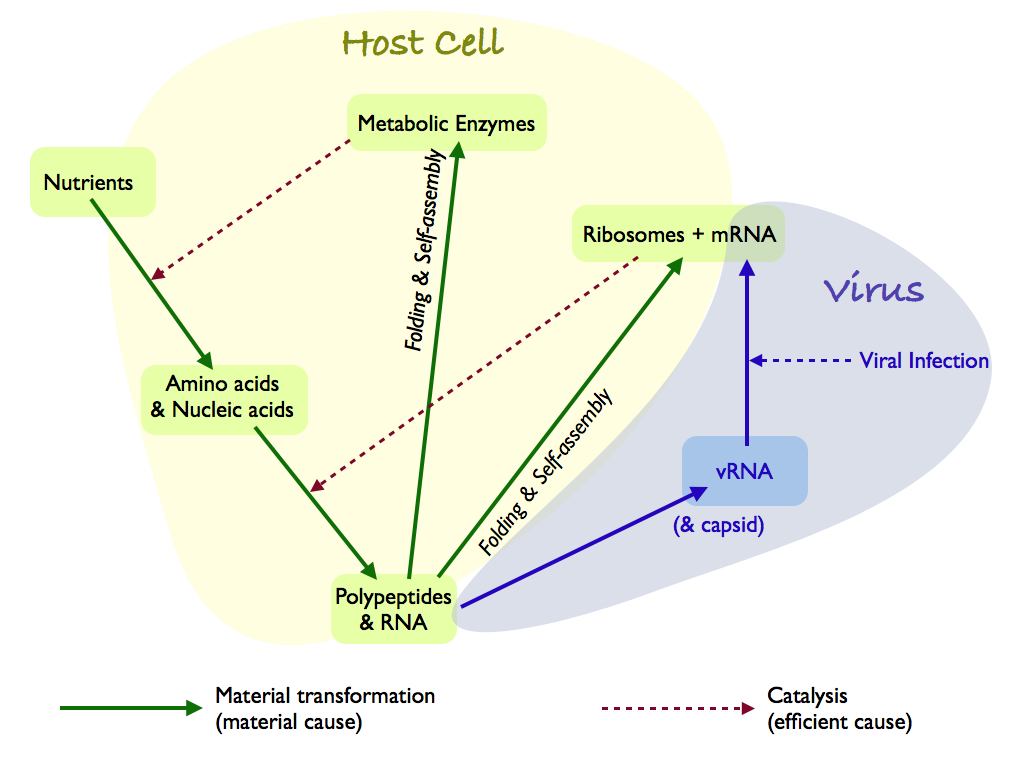
The Graphical Abstract of the BioSystems paper is iteself inspired by J. H. S. Hofmeyr's (2007) diagram of the cell.
March
We have just published The Science of COVID-19 . This page has just started, but we are rapidly adding to it.
Since the beginning of this year, progress has continued on updating and improving the pages of this website and the introduction of some new pages such as circular causation. Overall, Keith has been building up the site's coverage of Rosen's (M,R)-system theory and related topics, autocatalysis and causation. At some point this year, the emphasis will change focus onto molecular systems, but not yet. Meanwhile, A small team (names to be announced soon) has been developing a grant application for the Human Frontiers Science Programme to examine the question of what an ecological community really is, by using information theory metrics. Specifically, we mean - to what extent does it entail circular causation and thereby cybernetically match the requirements for an (M,R)-system and thereby be alive (noting that it has no boundary, so cannot be autopoietic in the normal sense). Speaking of which, many wonder what is and is not alive, in particular at this point in human history - are viruses alive? A short topical page on Covid-19 (corona virus) is our response to the current global crisis.
2019
November
The website makes continued (but slow) progress - Keith has been concentrating on pages that get the most 'hits', for example the one on autopoiesis. He has also joined Pedro Márquez-ZacarÃas in writing a paper for the journal Philosophies on the causal structure of organisms (the deadline is end of this year). That paper will highlight and build upon some of the tremendous insights of Robert Rosen (a true genius). Soon, we hope to attend to the rather neglected pages on the molecular biology theme, which are long overdue for it.
August
More website improvements, including the page on causation, featuring Rosen's (M,R)-systems, thanks to Pedro Márquez-ZacarÃas for encouraging me to include that here. The autopoiesis page has been improved a lot too.
May
More website updates (especially in synthesis and new pages: the cell as an engine and information bootstrap.
Keith is to attend the Mathematical Biosciences Institute (MBI) Summit on "the Rules of Life" in Columbia Ohio on 23-28 June 2019. He will be presenting work on Autonomy and taking part in scientific discussions about the fundamental rules governing life.
2018
DecemberWorking on a major update of the website over Christmas holidays - new pages being added and some old ones revised.
June
How Organisms Gained Causal Independence and how it might be quantified has been published by the journal Biology (this link takes you to the free publication page).
This work puts 'biological flesh' on the cybernetics 'skeleton' by explaining the evolutionary development of increasingly autonomous information processing systems used by organisms (from basic homeostasis all the way through to being able to anticipate and evaluate the consequences of potential actions). As such it synthesises a significant development in the understanding of information processing by biological systems.
2017
JulyCan a robot have free will? is published (click the title for a copy of it that is open access from the journal Entropy - it is better to download the PDF since their online copy does not render quite right on some systems).
This work elaborates the idea of downward causation by information control. It shows several things: 1) that for free will, a thing must be autonomous (and this is formally defined by transitive closure of the causal network, which gives formal meaning to the 'Kantian whole' idea of Kauffman, behind autopoiesis). 2) That an internal model is needed to generate hypothetical actions, evaluate them and select from among them according to an internally generated goal. 3) That free will is not a binary (all or nothing) attribute, it comes in levels which reflect the computational structure available for decision making. Ultimately, as evolved organisms, even humans have a limit to their self-generation of motive, in that all of us are ultimately directed by naturally selected motives. For all organisms, the highest level of decision making is natural selection.
The paper unifying concepts of function in biology has been published by Oikos. If you cannot download it from there, here is a preprint.
Keith has made IFB a 'project' on researchgate, which you can see here.
March
Our latest paper is "Can a robot have Free Will" : a pre-print of it can be found here.
In the paper, information theory and concepts such as downward causation, function and hierarchical autopoiesis are brought together to analyse the general question of free will.
February
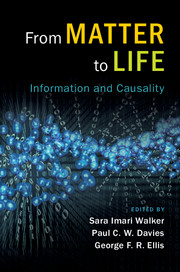
The book: From Matter to Life: Information and Causality is now available from book sellers. Chapter 13: Living through downward causation: from molecules to ecosystems by Keith D. Farnsworth, George F. R. Ellis and Luc Jaeger, is an extended explanation of our ideas on downward causation as they apply to living systems.
Our latest statement on Biological Function: Unifying concepts of biological function from molecules to ecosystems. by Keith Farnworth, Larissa Albantakis and Tancredi Caruso, has been uploaded onto the bioRxiv (archive prior to publication, intended for the journal Oikos).
Technical changes on this website have meant that the .net blog site is not currently available - this will be sorted out as soon as possible.
2016
NovemberThis month whatlifeis.net moves away from Queen's University Belfast to a commercial server. I made some minor changes to pages in preparation for that. More interestingly, we are planning for a new Theme on 'mind and action' to incorporate enquiry into the apparent freedom of organisms to act as they will and ultimately to investigate what information processing can tell us about consciousness and free-will.
We also congratulate Dr Larissa Albantakis on her winning a Templeton Foundation Fellowship to work on information and consciousness.
September
A major update has substantially improved the synthesis page.
We have started the development of a WordPress site at http://whatlifeis.net
There is a new page on Autopoisis which highlights work by Pier Luisi and a new page on the sequence paradox (part of the theme on the origin of life).
We welcome information and network theorist and neurologist Dr Larissa Albantakis to the network (see the Who page).
2015
DecemberA bit of time off for Christmas holidays has allowed for an update on several pages of this website and new material too. Notably a new page on the language of information terms, which sets out an organised structure for terms and builds a new draft for terminology in this area. Final preparations are also underway for the Cambridge University Press book (see August entry), which brings a new collaboration with the information philosopher Chris Timpson.
One important update to the site content is that the word 'epiphenomenon' has been replaced with 'transcendent complex' - this following creative discussion with the cosmologist and philosoper George Ellis (again see the August entry). I have also added to the library.
September
The German Centre for Integrative Biodiversity Research (iDiv) in Leipzig, Germany (of course!) hosted a group of us as a workshop titled "Functional Information: its potential for quantifying biodiversity and its relation to ecosystem functioning". We worked very hard all week! Here is the list of those present:
Dr Keith Farnsworth (coordinator) - UK
Prof Ivo Gross (vice-coordinator, bioinformatics expert, leader and local representative) - Germany
Dr Larissa Albantakis (network theorist and inspiring thinker) - USA / Germany
Prof Arto Annila (provided a deep thermodynamic- based theoretical foundation) - Finland
Dr David Ardell (introduced great new insights from molecular biology) - USA
Dr Keith Baverstock (contributed mind-expanding biological theory) -Finland / UK
Dr Christina Cobbold (mathemtician and biodiversty metric pioneer) - UK
Dr Lars Gamfeldt (crucial ecologist and biodiversity expert) - Sweden
Dr Olga Lyashevska (biodiversity metrics and big data expert -right down to the C-scripts!) - Netherlands / Ukraine
Dr Hyunju Kim (network theorist and mathematical support for all of us) - USA
Dr Thomas Schneider (pioneer of Shannon's information theory in biology) - USA
Dr Axel Rossberg (theoretical community ecologist and inspiring thinker) - UK / Germany.
A
report has been posted on this
webpage.
August
The book : "From Matter to Life: Information and Causality" to be published by Cambridge University Press has been compiled and edited. The book is edited by Paul Davies, Sara Walker and George Ellis. Keith Farnsworth wrote the chapter "Living through downward causation: from molecules to ecosystems" with George Ellis and Luc Jaeger, and co-wrote with the Oxford philosopher Christopher Timpson, a chapter on definitions of information. It should be out next year.
January
Biodiversity: The German Centre for Integrative Biodiversity Research (iDiv) has granted us full funding for a workshop to be held in Leipzig in September this year. More details can be found on the Biodiversity Theme pages.
We have added our first 'tutorial' paper: How much Information does DNA instantiate? (it is in the 'Molecular' theme).
Following the Arizona workshop, Keith Farnsworth is working with George Ellis and others to write two chapters for a book ( "Information and Causality: From Matter to Life") to be published by Cambridge University Press.
2014
OctoberKeith Farnsworth attended the Arizona State University Beyond Center workshop on
Information, Causality & the Origin of Life
This workshop was attended by leading thinkers in our subject area, including Sarah Walker (see our Origins Page). Topics discussed included: definitions of information; top-down causation, the biochemistry of proto-life and synthetic life; the thermodynamics of the origin of life; emergence and complexity. A book is planned, to be edited by Paul Davies (the organiser), Sarah Walker and George Ellis (cosmologist and leader in downward causation thinking).
September
Website: New webpage on molecular self-assembly and the role of physical forces in constructing the hierarchy of complexity leading to life. A few more library entries too.June
Website: Various paged get text updates and small errors corrected.Network Coordinator Dr Keith Farnsworth Invited to Arizona State University Beyond Centre workshop on the "Physics of Living Matter Information, Causality and the Origin of Life".
May
Website
officially
launched!
February:
IFB Website put online for testing.2013
December
IFB Website created: building starts offline.Throughout 2013, the network of scientists who will take part in the project is gradually built up.